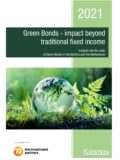The global green bond market has grown significantly in recent years, with Europe leading the way. Within Europe, Nordic and Dutch investors are often seen as advanced in their support of green bonds. If so, what do investors in these geographies think about the asset class? To find out, NN Investment Partners (NN IP) and Danish consultancy Kirstein A/S conducted research among institutional investors and wholesale distributors in the Nordic region and the Netherlands. The research shows that 45% of respondents regard green bonds as their preferred impact bond option and more than four out of five (81%) pension funds already invest in green bonds.
The research also reveals that Nordic investors tend to focus more on sovereign green bonds, allowing them to capitalize on their established in-house investment capability and expertise. Dutch investors, however, tend to favour the corporate green bond market — a market for which both Nordic and Dutch investors agree that external management is a prerequisite.
In both the Nordic and Dutch markets, dedicated sovereign and corporate options as well as aggregate solutions are favoured. Dutch investors currently tend to have more diversified green bond portfolios and take a pan-European or global approach to green bond investing. Their Nordic peers, in contrast, tend to focus on opportunities closer to home in their local markets but 30% expect to increase the proportion of green bonds they manage externally and increase allocations to corporate green bonds.
Casper Hammerich, Director at Kirstein: “Nordic investors have been at the forefront of the ESG adoption curve for many years. At the same time, they have also been behind a number of their European peers in transforming interest levels into allocations in Green Bonds. With this research, we show that the latter is no longer the case, and why the future for Green Bonds in the Nordic looks bright.”
Increased regulation and improved transparency resulting from the implementation of the EU Taxonomy and EU Green Bond Standard are also expected to give the market a positive impulse, with 87% of the research panel predicting that these developments will stimulate growth. NN IP has raised its full year 2021 issuance forecast to EUR 400 million because of similar expectations.
Bram Bos, Lead Portfolio Manager Green Bonds at NN Investment Partners: “Against a backdrop of market growth and improved regulation, it is great to see the broad-based and still rapidly growing interest in green bonds in these countries, which are ahead of the pack when it comes to green bond investing. The explosive growth in issuance – with the global market projected to exceed the EUR 1 trillion threshold by end-2021 – and further diversification of the issuer base will further enhance the green bond market’s appeal.”
Green bonds are seen as less volatile
Investors across the panel invest in green bonds for similar reasons. In terms of risk-return profiles, credit quality and volatility, there are no significant differences in the opinions of the Dutch and Nordic clients, although the Dutch are more positive. Volatility is perceived to be similar or lower to that of traditional bonds, while more than one third of the Nordics and half of the Dutch investors think credit quality is better.
For most respondents, sourcing better financial returns is not a high priority. The panel results are divided when it comes to the existence of a ‘greenium’: about a quarter of the panel anticipates a small premium (0 to +5 bps), while 41% expect bonds to be issued with a greenium (0 to -10bps), where investors pay more for a green bond than a regular bond. Dutch investors believe more strongly in the existence of premiums versus their Nordic counterparts.
Fears of greenwashing and limited capacity
Greenwashing is seen as the biggest barrier to investment. Nordic investors cite it as a clear argument for maintaining a high degree of internal management to control asset selection. Dutch investors, who allocate more to corporate green bonds, cite greenwashing as a major factor in using external managers with specific knowledge and expertise to mitigate this risk. The second barrier is the perceived risk of investing in a market with limited capacity, although participants are positive about the growth potential of the global green bond market.
Bram Bos added: “We appreciate that fear of greenwashing is a worry, but there is a solution – investors must do their homework. Given that issuers self-label their green bonds, it is imperative for investors to carry out their own in-depth research and not rely solely on the label. This assessment means looking closely at both the green projects being financed and the issuers to mitigate the risk of greenwashing. It also requires ongoing assessment and engagement to keep abreast of developments and to be able to flag any changes in the issuer’s sustainable strategy and goals.”
NN IP has completed its green bond range with the recent addition of a dedicated sovereign green bond strategy to complement its aggregate and corporate green bond strategies. This gives investors a full range of building blocks, offering every type of fixed income investor the opportunity to greenify their fixed income portfolios.
Read the full Kirstein report here.








